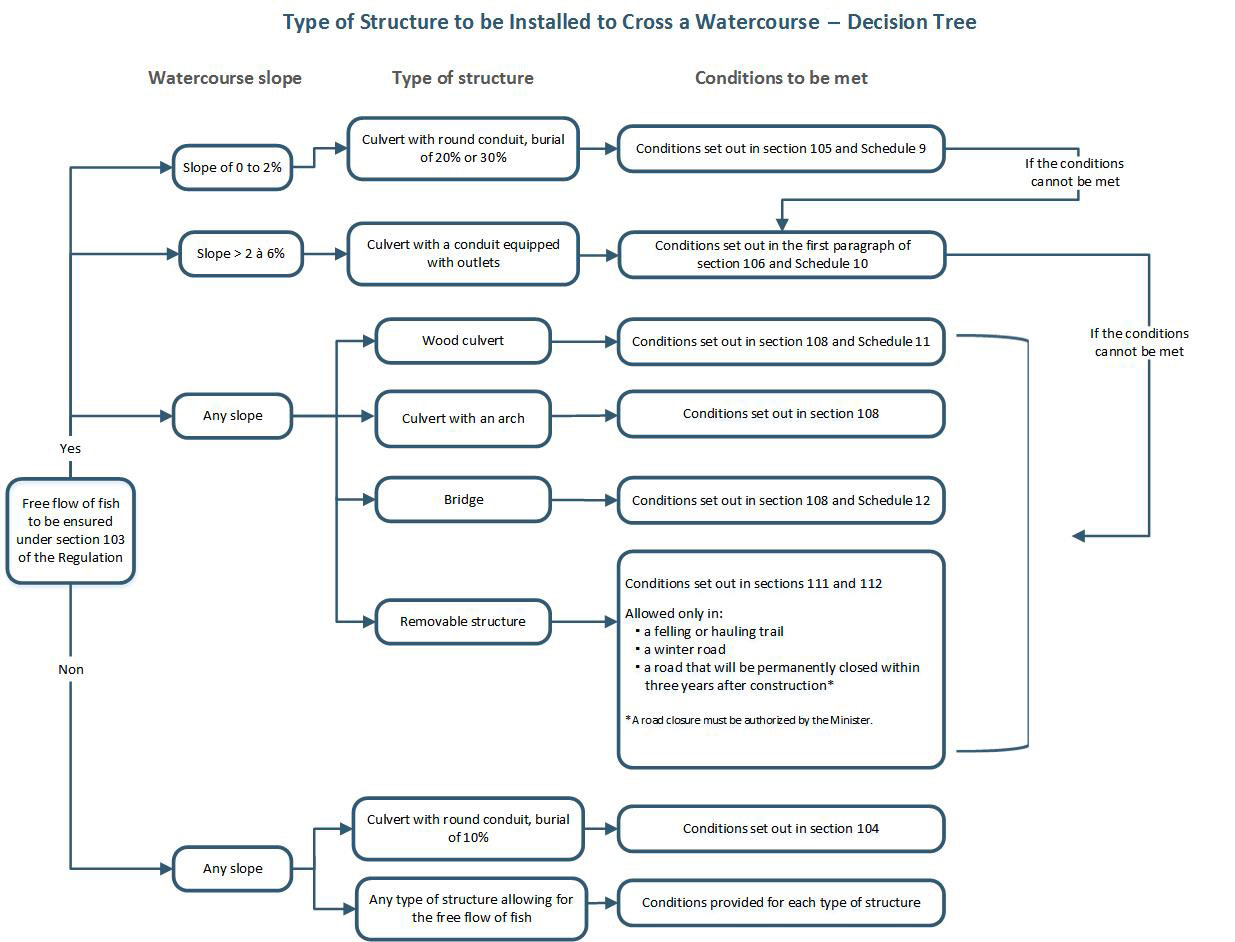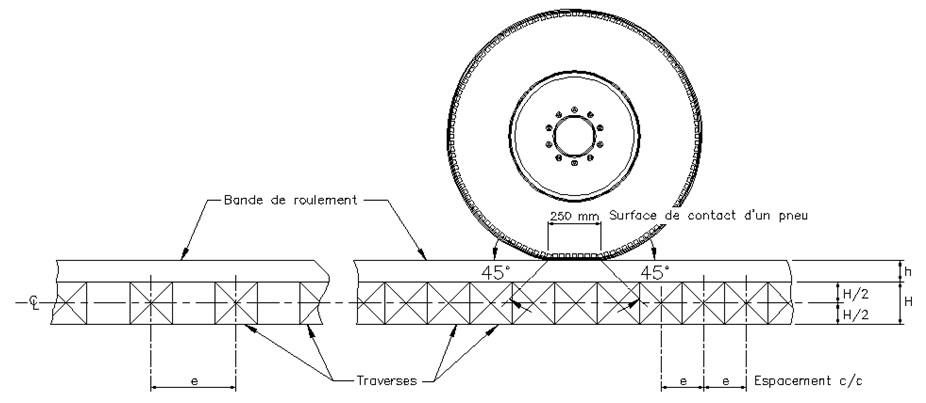Schedule 12
Conditions to be met when constructing, improving or repairing bridges
![]()
1
Additional information
The decision tree below can be used to decide on the type of structure that must be installed to cross a watercourse.
General requirements
Every intervention on bridges must comply with standard CAN/CSA-S6, Canadian Highway Bridge Design Code, that applies at the time the work is carried out.
Plan and specifications
Before the work:
For every construction, improvement and repair of bridges in forests, the design plans and specifications must be given to the department. The design plan contains the location map, the overall plan, the structure and foundation unit detailed plans, the geotechnical investigation (if the engineer or forest engineer who drew up the design deems it necessary or if the department so requires) and the topographical plan of the site. The drawing rules are those in the Manuel de conception des structures of the Ministère des Transports.
The design plans and specifications of bridges must be signed and sealed by an engineer or a forest engineer and, in the case of the bridges mentioned below, signed and sealed by an auditor (engineer or forest engineer):
- steel-concrete;
- with reinforced beams;
- with beams including splices;
- continuous span;
- on a bed of piles;
- Bailey;

2
Additional information
The Bailey bridges are truss bridges. All bridge drawings and specifications for triangulated beam design submitted to the Minister shall be signed and sealed by a forest engineer and signed and sealed by an auditor (engineer or forest engineer).
- bowed structure;
- with laminated-glued beams.
The shop plans must also be signed and sealed by an engineer or forest engineer and given to the department before the start of the work.
During the work :
All the plans and specifications of provisional works (cofferdam, timbering, erection system, temporary bridge, formwork, assemblies, etc.) must be signed and sealed by an engineer or forest engineer. The plans must be provided on request from the Minister.
After the work:
The final plan sealed, signed and dated by the engineer or forest engineer in charge of the work follow-up is given to the department. The plan represents the works as they are immediately after their carrying out.
The posting notice indicating the maximum load that a bridge may support and bearing the seal and signature of an engineer or forest engineer (and auditor if required), for CL3-W, CL2-W and CF3E-W trucks, must be provided to the department. The calculation notes must be provided on request to the Minister.
The final plan and the posting notice must be given to the department not later than 30 days following the end of the work and before posting on site.
![]()
3
Additional information
The posting notice shall indicate the maximum load that the entire structure can support, depending on the type of vehicle.
As provided for in section 117, the maximum load the bridge can support must be posted immediately upon completion of the work. This load limit will be validated by the MRNF following receipt of the final plan and posting notice and a change in posting may be required (if the posting determined by the MRNF differs from the posting indicated at the end of the work).
Geometry
The minimum usable width measured between the curbs is 4,300 mm for a bridge with one traffic lane.
The vertical clearance of a bridge, measured from the upper limit of the bank, is at least 1,000 mm. ![]()
4
Additional information
When the deck of a bridge is designed with a standard of the Ministère des Transports restraint system, the Ministère des Transports deck can be 4,100 mm wide.
For wooden bridges and steel-wood bridges with only one traffic lane
- a three-beam system is allowed for the CF3E-W configuration with a load less than or equal to 750 KN;
- a four-beam or more system must be used for the CF3E-W configuration with a load greater than 750 KN.
The dimensions of the abutments comply with the Manuel de conception des structures of the Ministère des Transports.
The construction of skeleton abutments is allowed for the CF3E-W configuration with a load less than or equal to 750 KN.
For the CF3E-W configuration with a load greater than 750 KN, the abutments are closed on three sides, except in the back, and they are constituted at least of 200 mm x 200 mm parts and at least 4 supports of 200 mm x 200 mm for the supports of the beams.
Loads considered and calculation parameters
The design and evaluation load configurations used are CL3-W, CL2-W and CF3E-W. ![]()
5
Objectives
- Ensure the sustainability of a road, bridge or culvert
- Ensure the safety of the forest road network users
Additional information
Where required, the CFHN-W design and evaluation load configuration is used.
The loads associated with the different configurations are as follows:
- CL3-W : 30 tons
- CL2-W : 48 tons
- CF3E-W : 60 tons
- CFHN-W: 150 tons
The impact factor on the bridge may not be reduced by considering a reduced speed posting or a mandatory stop.
Laminated-glued wood beams are calculated considering the resistance in wetlands. ![]()
6
Objectives
- Ensure the sustainability of a road, bridge or culvert
- Ensure the safety of the forest road network users
Explanations
Glued laminated timber beams can be considered, with the agreement of the Minister, in “semi-humid flexible environment for beam bending” (refer to CAN/CSA-S6, table 9.14), if the deck is designed in a ”semi-waterproof manner”. The term “semi-waterproof” implies that the beams are not exposed to conditions of continuous humidity.
In a non-exhaustive manner, a “semi-waterproof” deck can be characterized by:
- Protection of the beams top with a waterproofing membrane;
- The installation of a support device cutting the rising of humidity;
- The extension of the tread without backfill to above the abutments.
The limits for the allowable deflections to be used are L/400 for the calculation of wood-wood bridges, L/600 for steel-wood bridges (determined under standard CAN/CSA-S6-88) and L/800 for all other types of bridges.
The number of wood stretchers taking part in the stress under a tire is calculated using the following method:
Number of stretchers taking part in the stress under a tire= (250 + 2h + H)/e
h = height of the running strips
H = height of the stretchers
e = space between the stretchers (measured centre to centre)
A stretcher may be added to the calculation obtained where 25% or more of the stretcher is used. See example in table 1..
Material
The wood used for the construction of the abutments, piers and restraint system of a bridge is Eastern or Western hemlock, grey or red pine, spruce, tamarack or Douglas fir.
The wooden parts constituting the various elements of the bridge must meet the following requirement:
- foundation units (abutments and piers) are constructed using quality 1 and 2 wood parts, whatever the proportion.
- the floor joists are always made of quality 1 Eastern hemlock;
All the wooden parts constituting the floor joists are stamped (engraved stamp) at one end to recognize the quality, even when wooden parts are treated. - the running strip, curbs and guard rails are constructed with quality 1 and 2 parts, namely, 65% minimum quality 1 parts and 35% maximum quality 2 parts.
The use of used steel in good condition is allowed if there is a quality control that determines its resistance. The minimum resistance allowed is 230MPa.
The beams and plates are made of 350 AT or 350 W steel.
The bracing angles are made of 300W steel.
Assembly bolts, rings and nuts are type A-325.
Construction
The wood or steel abutments and piers loaded with rocks must be buried at least 600 mm under the upper limit of the bank, except in the presence of rock. If the ground is very hard (cannot be excavated by a backhoe), it may be used as bankseat. No wood abutment may have less than 8 rows from the bottom to the level of the supports of the beams. ![]()
7
Objectives
- Ensure the sustainability of a road, bridge or culvert
- Ensure the safety of the forest road network users
Explanations
If the topography of the terrain and the presence of rock do not allow the minimum eight rows from the base to the level of the supports, a wooden abutment of fewer than eight rows may be accepted if the first row of abutment is properly anchored to the rock foundation. This was agreed upon with departmental officials. The abutment shall be closed on three sides (not skeleton).
All the bases of the reinforced concrete foundation units, except those on solid rock, must be extended under the frost level (minimum depth of 1.5 m).
The natural ground (mineral) used as the seat of the foundation unit must not be disturbed or reworked.
The curbs, at a height at least 400 mm above the running strip, include a minimum of 200 mm x 200 mm continuous wooden parts supported on support blocks 300 mm x 300 mm x 600 mm long. The blocks are at a maximum distance of 1,800 mm (distance centre-to-centre). The curbs are attached by bolts having a diameter of 19 mm.
The running strip is full width and composed of wooden parts 100 mm high X 200 mm wide.
For a deck made of wood parts, at least one stretcher out of three is attached to the beams.
If the bridge requires piers in the watercourse, a ballast is required all around to counter underwashing.
The ripraps or ballasts are made of rocks and pebbles of various sizes of a minimum of 200 mm placed in locations indicated in the plans and on the sand and gravel bank. The ripraps at the abutments must protect the embankment up to a minimum height of one metre above the banks.
Prohibited material and practices
The material and practices listed below are prohibited:
- beam reinforcements, splices, braces and stiffeners attached by on-site welding;
- structures without braces;
- vehicle chassis (trailer, railway car, etc.);
- railroad tracks;
- reclaimed riveted beans;
- reclaimed lattice girders;
- overlapping decks;
- torch cutting of steel elements (girder, brace, etc.);
- holes cut using a torch.
Bridges located on trails for all terrain vehicles
Bridges located on trails for motorized all terrain vehicles must meet the preceding conditions, subject to the following:
The maximum load capacity is posted on all bridges. The notice bearing the seal and signature of an engineer or forest engineer (and auditor where required) for the CL3-W configuration is provided to the department at the end of the work. The calculation notes are provided on request to the Minister.
The design and evaluation load configuration used is CL3-W.
Wood or steel abutments and piers loaded with rocks must extend at least 300 mm under the natural land where the abutments are installed. If the ground is very hard (cannot be excavated by a backhoe), it may be used as bank.
A bridge located on a trail for motorized all terrain vehicles will have to be designed for a minimum load of 10 tonnes for the CL3-W configuration.
The running strip must be full width and made of wooden parts at least 50 mm thick. A space may be left between the wooden parts without exceeding 75 mm.



